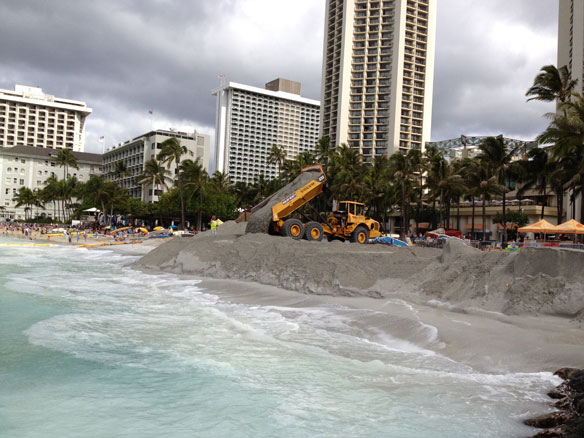Photograph: Waikiki beach-renourishement, 2012 © SAF — Coastal Care.
“Hawaii’s famed Waikiki Beach started to erode again, less than a year after the completion of a $2.2 million project to replenish the sand on about 1,730 feet of shoreline that had been suffering from chronic erosion.”Captions.
“Development is absolutely responsible for the majority of the beach nourishment,” Andrew Coburn, assistant director of The Program for the Study of Developed Shorelines at Western Carolina University, said. “Well over 99 percent of the shorelines that are nourished are developed so there is some economic value placed behind them.”
Erosion in Waikiki has been a long-time concern and the City and County of Honolulu is once again looking for solutions to combat the problem…
Also of Interest:
Waikiki Beach Is Totally Man-Made And Disappearing. Can Hawaii Save It?Huffington Green (03-10-2015)
Doubling of Coastal Erosion by Mid-Century in Hawai’i, Science Daily (03-24-2015)
Chronic erosion dominates the sandy beaches of Hawai’i, causing beach loss as it damages homes, infrastructure, and critical habitat. Researchers have long understood that global sea level rise will affect the rate of coastal erosion. However, new research indicates that coastal erosion of Hawai’i’s beaches may double by mid-century…
Seawalls: Ecological effects of coastal armoring in soft sediment environments; Science Daily (07-24-2017)
For nearly a century, America’s coasts — particularly those with large urban populations — have been armored with human made structures such as seawalls. These structures essentially draw a line in the sand that constrains the ability of the shoreline to respond to changes in sea level and other dynamic coastal processes…
“Seawalls Kill Beaches,” Open Letters by Warner Chabot And Rob Young; (10-03-2014)
Living on the shores of Hawaii: natural hazards, the environment, and our communities, A book by Chip Fletcher; Robynne Boyd, William J. Neal and Virginia Tice.
“Living on the shores of Hawaii: natural hazards, the environment, and our communities” addresses a wide range of environmental concerns within the context of sustainability and their influence on the future of Hawaii…
Sandbagging at the Shore: North Carolina’s Coastal Sand Bags and Political Sandbaggers; By William Neal, Orrin Pilkey & Norma Longo;
The wonder of modern English is how social use of language expands and changes the meaning of words. Sand bag is a bag filled with sand used for temporary construction—quickly made, easily transported, and easily removed. Typically, sandbagging is the emplacement of sand bags to construct a temporary protective wall or barrier, such as a dike or dam to hold back flood waters , or protection on the battlefield. But the term ‘sandbagging’ has taken on an array of other meanings…
Protecting The Netherlands’ Vulnerable Coasts With A ‘Sand Motor’; NPR (11-25-2017)
Are we loving our beaches to death? Survey says ‘yes’; Bay of Plenty Times (01-13-2017)
Let’s end war with ocean, Op-Ed by Orrin H. Pilkey
The immediate future most certainly holds more miles of sandbags, resulting in more narrowed and ugly beaches.But this trend can be halted and reversed. Now is the time to make peace with the ocean.The time is now to stop sandbagging, both physically with no more shore-hardening structures, and politically with no more exceptions to the intent of the rules, no more undermining existing legislation, and a return to enforcement…
“The Beaches Are Moving,” A Video featuring Orrin Pilkey, PhD
World famous coastal geologist Orrin H. Pilkey takes us to the beach and explains why erosion has become a problem…
In response to the detrimental environmental impacts caused by traditional erosion control structures, environmental groups, state and federal resource management agencies, now advocate an approach known as “Living Shorelines”that embraces the use of natural habitat elements such as indigenous vegetation, to stabilize and protect eroding shorelines.









